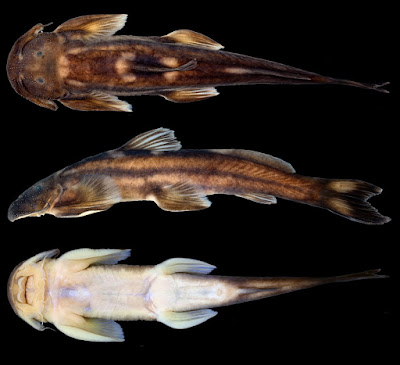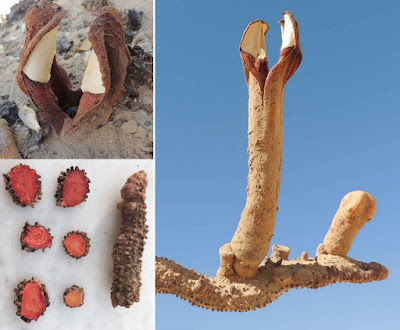[Most Recent Entries] [Calendar View]
Sunday, February 11th, 2018
| Time | Event | ||||
| 5:07a | [Ichthyology • 2018] Order Zeiformes: Phylogenetic Relationships Based on Molecular and Morphological Data
The Zeiformes (dories) are mid-water or deep (to 1000 m) marine acanthomorph fishes with a global, circumtropical, and circumtemperate distribution. Some species have a near-worldwide distribution, while others appear to be regional endemics, e.g., near New Zealand. Six families, 16 genera, and 33 species are currently recognized as valid. Relationships among them, however, remain unsettled, especially in light of recent proposals concerning the phylogenetic placement of zeiforms within the Paracanthopterygii rather than allied with beryciforms or percomorphs. The present study uses both morphological and molecular characters to investigate zeiform interrelationships given their revised phylogenetic placement and attendant changes to their close outgroups. Results indicate that revised outgroups affected the phylogenetic conclusions, especially those based on morphology. All analyses recovered monophyletic Zeidae, Cyttidae, and Oreosomatidae. Zeniontidae were recovered as polyphyletic, with the clade Capromimus + Cyttomimus sister to Oreosomatidae. Based on morphological evidence, Grammicolepididae are paraphyletic. Parazenidae are monophyletic in all results except maximum likelihood based on molecular data. Morphometric analysis revealed a star-like radiation in morphospace with three diverging trends, each trend exemplified by convergences in body form. Overall, our results are suggestive of a rapid diversification among the major lineages of Zeiformes during the Late Cretaceous. Terry C. Grande, W. Calvin Borden, Mark V. H. Wilson and Lindsay Scarpitta. 2018. Phylogenetic Relationships among Fishes in the Order Zeiformes Based on Molecular and Morphological Data. Copeia. 106(1); 20-48. DOI: 10.1643/CG-17-594 | ||||
| 2:08p | [Ichthyology • 2018] Exostoma sectile • A New Glyptosternine Catfish (Siluriformes: Sisoridae) from Northern Myanmar
A new species of sisorid catfish in the genus Exostoma is described from the upper Irrawaddy River drainage in northern Myanmar. The new species can be distinguished from congeners by the condition of the posterior extremity of the adipose-fin base, the degree of tuberculation in the preorbital area, as well as morphometric data for the nasal barbel length, snout length, interorbital distance, adipose fin-base length, body depth at anus, caudal-peduncle length, and caudal-peduncle depth. The taxonomic status of congeners in the Irrawaddy River drainage is also discussed, and E. chaudhurii is revalidated as a distinct species.
Exostoma sectile, new species Distribution.— This species is known from a single locality near Putao in the upper Irrawaddy River drainage in northern Myanmar. Etymology.— The specific epithet comes from the Latin adjective sectilis, -is, -e, meaning cut or cleft. This is used in reference to the presence of a distinct incision or notch at the posterior extremity of the adipose-fin base in this species. Heok Hee Ng and Maurice Kottelat. 2018. A New Glyptosternine Catfish from Northern Myanmar (Teleostei: Siluriformes: Sisoridae). Copeia. 106(1); 63-69. DOI: 10.1643/CI-17-613 | ||||
| 2:10p | [Botany • 2018] Hydnora arabica • A New Species (Aristolochiaceae) from the Arabian Peninsula and A Key to Hydnora
Abstract The plant parasite Hydnora arabica (Aristolochiaceae) is described from the Arabian Peninsula. This species was previously identified as Hydnora africana in Oman. It can be separated from other Hydnora taxa primarily by its terete rhizome, red to orange inner perianth tube color, and tepal lobe margins entirely covered with dense strigose setae. In Oman, Hydnora arabica is known to parasitize two leguminous trees: Acacia tortilis and the introduced Pithocellobium dulce, but may parasitize additional Fabaceae. At least eleven synonyms or subspecific varieties of H. abyssinica are described in the literature, all from east or southern Africa. These synonyms are discussed in light of new observations of morphology including tepal margin ornamentation. A new key for Hydnora is proposed. Keywords: parasitic plant, Hydnoraceae, Magnoliids Hydnora arabica Bolin & Musselman, sp. nov. Diagnosis: — Hydnora arabica is similar to Hydnora abyssinica, but can be distinguished by having red to orange inner perianth tube color and tepal lobe margins entirely covered with dense strigose setae. Distribution:—Known from southern Oman (Dhofar region) and Yemen. Collected from an elevation of 200 to 680 m (Fig. 1). Habitat and Ecology:—Hydnora arabica is an obligate root parasite of Fabaceae that is visible above the soil surface only when flowering (Fig. 2). Most of our collections in Oman occurred on Acacia tortilis and the same host was reported from Yemen (Al-Fatimi 2015). Interestingly, in a small Dhofar settlement approximately 16 km NE of Mirbat, adjacent to Ayn Ayuoon south of Jebel Samhan, we were directed to a robust H. arabica population associated with and below the non-native Pithocellobium dulce (5 m high) in the settlement courtyard and goat yard. No other potential host trees were within 50 meters, thus P. dulce was likely the host plant. The villagers mentioned that the goats fed in the nearby wadi where H. arabica was abundant and were the likely vector of Hydnora seeds into the settlement. Interestingly, in Madagascar, the same introduced host P. dulce was a common host of H. esculenta (Bolin and Musselman 2013). .... Etymology:—The specific epithet refers to the distribution of H. arabica on the Arabian Peninsula. Vernacular Name:— Thesiger reported the vernacular name as dhanuna on herbarium material from the 1940s. Miller and Morris (1998) give the Jibbali name xamleg and the Dhofari Arabic names khamlayyeh and khumla’ah. We can confirm that Jibbali settlers in Dhofar that knew the plant well as a potential food item in fruit used the name xamleg. From Yemen in the districts of Lawdar and Dathina that use the plant the Arabic local names of nabeekh, fateekh, and tarateef (Al-Fatimi et al. 2015) are used. Conservation Status:— In the Dhofar region of Oman, dried rhizomes of H. arabica were common in most wadi beds with an abundance of its common host Acacia tortilis, though fresh flowering material was difficult to locate due to its infrequent flowering and primarily hypogeous habit. Based on our observations, the conservation status of H. arabica in southern Oman is secure. However, H. abyssinica is reported as rare in Saudi Arabia (Collenette 1999) and we have little basis to comment on H. arabica abundance in Yemen. Jay F. Bolin, Darach Lupton and Lytton J. Musselman. 2018. Hydnora arabica (Aristolochiaceae), A New Species from the Arabian Peninsula and A Key to Hydnora. Phytotaxa. 388(1); 99–108. DOI: 10.11646/phytotaxa.338.1.8 | ||||
| 2:31p | [Ichthyology • 2018] Microphilypnus hypolyrasimeion • A New Species of Miniature Fish of the Genus Microphilypnus Myers, 1927 (Gobioidei: Eleotridae) from the Upper Rio Negro Basin, Amazonas, Brazil
A new species of the eleotrid genus Microphilypus from the Upper Rio Negro basin is described herein. It differs from all congeners in the presence of 5–6 arched rows of melanophores on the abdominal region, posterior to the base of the pelvic fins, followed by six large irregularly oval black blotches, with the tips of the three posteriormost blotches visible in lateral view; a dark teardrop-shaped blotch on the caudal peduncle, extending to the base of the ventral caudal rays; five light brown blotches along the dorsal profile of the body, between the origin of the second dorsal fin and the caudal peduncle; and the poorly developed laterosensory system on the head, with horizontal rows of head papillae b and d absent. A key to the species of Microphilypnus is presented. Rodrigo A. Caires and Mônica Toledo-Piza. 2018. A New Species of Miniature Fish of the Genus Microphilypnus Myers, 1927 (Gobioidei: Eleotridae) from the Upper Rio Negro Basin, Amazonas, Brazil. Copeia. 106(1); 49-55. DOI: 10.1643/CI-17-634 |
| << Previous Day |
2018/02/11 [Calendar] |
Next Day >> |








